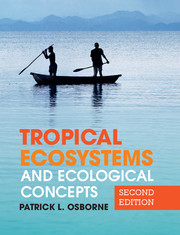Book contents
- Frontmatter
- Contents
- Preface
- Abbreviations and units
- Chapter 1 The tropical environment and climate
- Chapter 2 Dry, hot deserts and environmental factors
- Chapter 3 Grasslands and primary production
- Chapter 4 Savanna and population dynamics
- Chapter 5 Lakes, energy flow and biogeochemical cycling
- Chapter 6 Rivers, floodplains and estuaries
- Chapter 7 Wetlands and succession
- Chapter 8 Tropical rain forests and biodiversity
- Chapter 9 Mountains, zonation and community gradients
- Chapter 10 Mangroves, seagrasses and decomposition
- Chapter 11 Coral reefs and community ecology
- Chapter 12 Islands, archipelagos, biogeography and evolutionary ecology
- Chapter 13 Cities and human ecology
- Glossary
- References
- Index
- References
Chapter 9 - Mountains, zonation and community gradients
Published online by Cambridge University Press: 05 June 2012
- Frontmatter
- Contents
- Preface
- Abbreviations and units
- Chapter 1 The tropical environment and climate
- Chapter 2 Dry, hot deserts and environmental factors
- Chapter 3 Grasslands and primary production
- Chapter 4 Savanna and population dynamics
- Chapter 5 Lakes, energy flow and biogeochemical cycling
- Chapter 6 Rivers, floodplains and estuaries
- Chapter 7 Wetlands and succession
- Chapter 8 Tropical rain forests and biodiversity
- Chapter 9 Mountains, zonation and community gradients
- Chapter 10 Mangroves, seagrasses and decomposition
- Chapter 11 Coral reefs and community ecology
- Chapter 12 Islands, archipelagos, biogeography and evolutionary ecology
- Chapter 13 Cities and human ecology
- Glossary
- References
- Index
- References
Summary
Tropical mountains experience ‘summer every day and winter every night’.
(HEDBERG 1964).Organisms living on mountains anywhere in the world experience environmental conditions peculiar to high altitudes: decreased atmospheric pressure, lower temperatures, lower oxygen tensions and greater exposure to wind and ultraviolet light. The thin atmosphere at high elevations facilitates rapid dissipation of heat, and this leads to large disparities in temperatures between sun and shade environments and between night and day temperatures. This last feature is particularly true of tropical mountains which experience large temperature differentials between night and day, hence the quote at the start of this chapter.
Organisms living on mountains exhibit physiological adaptations to low temperatures, freeze–thaw cycles, low atmospheric pressure and low oxygen tensions. On tropical mountains, environmental factors vary little seasonally, and wide diurnal temperature range accommodates vegetation that grows slowly and shows little sign of seasonality in reproductive activity. These environmental trends in altitude are reflected in changes in the structure, species composition and diversity of the vegetation, and montane plant and animal communities may form distinct zones in response to these changing conditions. Using Mount Wilhelm in Papua New Guinea, the Andes in Ecuador and Mount Kenya as study sites, montane zonation and adaptations exhibited by plants and animals living on tropical mountains are described. This chapter concludes with a discussion of community ecology and how communities respond to environmental gradients.
- Type
- Chapter
- Information
- Tropical Ecosystems and Ecological Concepts , pp. 315 - 333Publisher: Cambridge University PressPrint publication year: 2012
References
- 2
- Cited by



